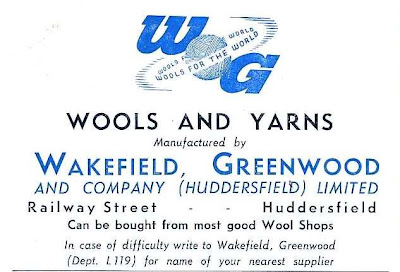 |
| Greenwoods ad in Vogue Knitting, 1946 |
Greenwoods (of Victoria Street, Huddersfield) initially advertised a mail order service:
"Greenwoods can supply you with all the Wools and other threads mentioned in this and other Vogue issues. ... In addition, any of the garments can be supplied COMPLETELY HAND-KNITTED & READY TO WEAR at reasonable prices from 12/6 upwards. Ask for a quotation for your favourite garment made to measure."It seems a bit odd to read a knitting magazine and then pay someone else to do the knitting for you, but the ad appeared for several years, so I assume that it was a successful service.
The Victoria Street business appeared in a 1937 Huddersfield trade directory as "Miss Greenwood, Wool and Handicraft Depot". So it appears that at that time, the company was only supplying yarns made elsewhere - interesting that it was owned by a woman. Towards the end of the war, Greenwoods started advertising their own yarns, and then from 1946 the Vogue Knitting ads featured their own designs as well. In 1946 (between the two issues of Vogue Knitting) the company changed its name to Wakefield, Greenwood, and moved to Railway Street. I wonder what had happened? Was Miss Greenwood still involved in the business? Had she got married to Mr Wakefield?
 |
| W.G. pattern leaflet 119, early 1950s |
 |
| Back of W.G. leaflet 119 |
Wakefield, Greenwood continued to advertise into the 1950s, and I hoped to find one of their patterns at Lee Mills. One eventually appeared a couple of weeks ago - from the early 1950s, I guess. But it was still a bit mysterious. They claim to manufacture the yarns they are selling, but there cannot possibly have been a spinning mill on Railway Street, or even a warehouse - there is nowhere to put one. So either they were actually buying in yarn from other companies, or their mill was somewhere else - but then why wasn't their office at the mill?
Then this week, I found a whole box of W.G. patterns. The styles appear to date from the 1950s and early 1960s. By sorting them into numerical order, and looking at the ads in Vogue Knitting too, it's possible to follow the development of the company. At some time in the late 1950s, the company was renamed W.G. Spinners Ltd, but remained at Railway Street. And then a little later, in the early 1960s, the address changed to "Wakefield Mills, Thornhill Beck Lane, Brighouse".
 | |
| Ad for W.G. Spinners, 1962 |








